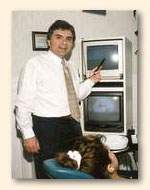A Tiny Color TV Camera is Us Used to Examine the Teeth and Gums
 To better see all areas inside the patient's mouth, Dr. Kezian uses a tiny color TV camera which carries it's own light, so all the images are sharp and brightly lit and highly magnified, and displayed live on the computer screen at the dental chair.
To better see all areas inside the patient's mouth, Dr. Kezian uses a tiny color TV camera which carries it's own light, so all the images are sharp and brightly lit and highly magnified, and displayed live on the computer screen at the dental chair.
This ability to see a clear, magnified color image of all surfaces inside the mouth enables Dr. Kezian to spot trouble early, and treat it before it causes serious damage.
The technology allows Dr. Kezian to freeze images as he's exploring the inside of the patients mouth. He can then point out to the patient on the computer screen exactly what the problem is, and explain what techniques he will use to cure the problem.
Using the intra-oral camera, Dr. Kezian can often spot problems which couldn't be seen with the naked eye and a dental mirror.
Intra-Oral Video Imaging, Dentistry Enters the Computer Era
Perhaps you've heard about it from a friend or you may have seen it on the Discovery Channel; but what is Intraoral Video Imaging anyway and what role does it play in my oral examination?
Several years ago the computer industry felt that the ability to communicate was being hampered by the inadequacies of verbal communication. Most of what you listen to is either never really heard or else it is just too easily forgotten. Our goal is to inform you about your dental health so that you can make an educated decision regarding your own care. Active participation in the oral health process is a must if we are to accomplish our mutual goals.
Intraoral video imaging involves the use of a small camera with a fiber optic light source small enough to be placed within the mouth. This camera is attached to a computer which allows the images of your teeth to be displayed on the computer monitor. These intraoral images can then be stored by the computer or printed out just like a photograph.
One of the nice things about computers is their ability to store these images in their memory, indefinitely. We can access these images whenever we want in order to compare one recare examination with another. At the same time, the computer allows us to send copies of these images to other dentists or physicians thereby improving our ability to consult on issues that may be of strategic importance. A picture is truly worth a thousand words.
Some of the conditions we can see with an intraoral camera that are difficult to see with the naked eye include : various types of oral pathology and lesions, broken fillings and other types of restorations, cracked teeth, a variety of gum conditions and cavities in areas that are difficult to see and reach. You will be amazed by the quality of the images and just how diagnostic they really are.
Another intriguing aspect of imaging is its ability to use the computer to predict cosmetic alterations without ever actually having to touch a tooth. Close a space, change the shape of a tooth or just see what your teeth would look like a shade whiter. It's all possible with Cosmetic Imaging!
Laser Dentistry
- You're about to have your first experience with a new and exciting technology. LASERS. A million questions are probably going through your mind. Perhaps you've head about dental lasers on T.V. or on the radio. Just in case you haven't had the opportunity to learn about lasers, I want to give you some basic information and maybe even allay some of your concerns regarding dental laser treatment.
- Dental lasers are designed to assist the dentist in the treatment of the gingival tissues ( gums ). They have been approved by the Food and Drug Administration for the use on gum tissue only. We will not, therefore, be using the laser on your teeth. Sometime in the near future there will be a dental laser specifically designed for use on the teeth. But not just yet....
- The laser your dentist may use looks similar to the picture in the upper right hand corner of this page. When you are seated in the operatory, one of the dental assistants will give you a pair of safety glasses to wear, position the laser next to the dental chair, and place a sterile laser tip in the sterilized handpiece. You will then be ready to go. Unlike the dental drill, there is no whining sound to disturb your sleep or to make you grip the sides of the dental chair. The only noise you will hear will be the slight hissing sound of the air jet that is attached to the laser. According to most of our patients, this silent feature is definitely a big plus !
Dental lasers can be used for a variety of treatment procedures. Depending upon the treatment needs, your dentist may use the laser for several minutes or possibly for only a brief moment. However, even those procedures that require only a short period of laser usage, benefit from the many advantages of laser therapy. Bleeding is minimized, swelling is controlled and there is usually little if any postoperative discomfort. For maximum comfort, most of the procedures do, however, require a local anesthetic. This will be discussed with you prior to the beginning of the treatment session.
